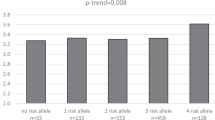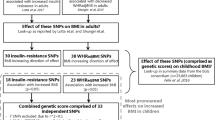Abstract
Objective:
A Val1483Ile polymorphism in the human fatty acid sythase gene (FAS) has recently been shown to be associated with lower percentage of body fat and substrate oxidation rates in Pima Indians, but its role in other populations has not been described. Here, we investigate the effect of this variant on obesity in Caucasian children and adolescents.
Subjects and methods:
In total, 738 Caucasian children and adolescents aged 6–17 years of the Leipzig Schoolchildren cohort, which constitutes an unselected representative German population and 205 obese children (body mass index (BMI) 2.71±0.04 SDS) were genotyped for genotype–phenotype associations.
Results:
The frequency of the Ile-allele was lower in German Caucasians compared with Pima Indians (0.03 compared to 0.10). Using generalized linear regression models, there was no effect of the polymorphism on BMI in the whole normal population. However, we identified a significant interaction effect between sex and genotype (P=0.004). Subsequent sex stratified analyses revealed a lower BMI SDS in boys with Ile/Val genotype compared to Val/Val (−0.36±0.29 vs 0.09±0.05, P<0.05), while an opposite effect was observed in girls (0.48±0.19 vs 0.09±0.05, P<0.05). In genotype–phenotype associations in obese children, the polymorphism did not affect parameters of insulin, glucose, or lipid metabolism in the whole population. Again, however, obese boys with Ile/Val genotype had significantly higher high-density lipoprotein (HDL) cholesterol levels (1.46±0.07 vs 1.23±0.03 mmol/l, P<0.05).
Conclusion:
In conclusion, our findings suggest a sex-specific protective effect of the Val1483Ile polymorphism in FAS for obesity in Caucasian boys. In addition, the polymorphism may be associated with a beneficial lipid profile in obese boys.
This is a preview of subscription content, access via your institution
Access options
Subscribe to this journal
Receive 12 print issues and online access
$259.00 per year
only $21.58 per issue
Buy this article
- Purchase on Springer Link
- Instant access to full article PDF
Prices may be subject to local taxes which are calculated during checkout

Similar content being viewed by others
References
Kiess W, Blüher S, Kapellen T, Böttner A . Obesity, childhood and adolescence. Encyclopedia of Endocrine Diseases. Elsevier Inc: Amsterdam, 2004. pp 403–407.
Kiess W, Böttner A, Raile K, Kapellen T, Müller G, Galler A et al. Type 2 diabetes mellitus in children and adolescents: a review from a European perspective. Horm Res 2003; 59: 77–84.
Damcott CM, Sack P, Shuldiner AR . The genetics of obesity. Endocrinol Metab Clin North Am 2003; 32: 761–786.
Semenkovich CF . Regulation of fatty acid synthase (FAS). Prog Lipid Res 1997; 36: 43–53.
Norman RA, Tataranni PA, Pratley R, Thompson DB, Hanson RL, Prochazka M et al. Autosomal genomic scan for loci linked to obesity and energy metabolism in Pima Indians. Am J Hum Genet 1998; 62: 659–668.
Loftus TM, Jaworsky DE, Frehywot GL, Townsend CA, Ronnett GV, Lane MD et al. Reduced food intake and body weight in mice treated with fatty acid synthase inhibitors. Science 2000; 288: 2379–2381.
Kovacs P, Harper I, Hanson RL, Infante AM, Bogardus C, Tataranni PA et al. A novel missense substitution (Val1483Ile) in the fatty acid synthase gene (FAS) is associated with percentage of body fat and substrate oxidation rates in nondiabetic Pima Indians. Diabetes 2004; 53: 1915–1919.
Knowler WC, Bennett PH, Hamman RF, Miller M . Diabetes incidence and prevalence in Pima Indians: a 19-fold greater incidence than in Rochester, Minnesota. Am J Epidemiol 1978; 108: 497–505.
Reich A, Müller G, Gelbrich G, Deutscher K, Godicke R, Kiess W . Obesity and blood pressure-results from the examination of 2365 schoolchildren in Germany. Int J Obes Relat Metab Disord 2003; 27: 1459–1464.
Kromeyer-Hauschild K, Wabitsch M, Geller F, Ziegler A, Geißa HC, Hesse V . Perzentile für den Body Mass Index für das Kindes- und Jugendalter unter Heranziehung verschiedener deutscher Stichproben. Monatsschr Kinderheilkd 2001; 149: 807–818.
Franks PW, Knowler WC, Nair S, Koska J, Lee YH, Lindsay RS et al. Interaction between an 11betaHSD1 gene variant and birth era modifies the risk of hypertension in Pima Indians. Hypertension 2004; 44: 681–688.
Havel PJ, Kasim-Karakas S, Dubuc GR, Mueller W, Phinney SD . Gender differences in plasma leptin concentrations. Nat Med 1996; 2: 949–950.
Francke S, Clement K, Dina C, Inoue H, Behn P, Vatin V et al. Genetic studies of the leptin receptor gene in morbidly obese French Caucasian families. Hum Genet 1997; 100: 491–496.
Mattevi VS, Zembrzuski VM, Hutz MH . A resistin gene polymorphism is associated with body mass index in women. Hum Genet 2004; 115: 208–212.
Damcott CM, Feingold E, Moffett SP, Barmada MM, Marshall JA, Hamman RF et al. Genetic variation in uncoupling protein 3 is associated with dietary intake and body composition in females. Metabolism 2004; 53: 458–464.
Ma L, Tataranni PA, Hanson RL, Infante AM, Kobes S, Bogardus C et al. Variations in peptide YY and Y2 receptor genes are associated with severe obesity in Pima Indian men. Diabetes 2005; 54: 1598–1602.
Ridderstrale M, Carlsson E, Klannemark M, Cederberg A, Kosters C, Tornqvist H et al. FOXC2 mRNA Expression and a 5' untranslated region polymorphism of the gene are associated with insulin resistance. Diabetes 2002; 51: 3554–3560.
Kovacs P, Lehn-Stefan A, Stumvoll M, Bogardus C, Baier LJ . Genetic variation in the human winged helix/forkhead transcription factor gene FOXC2 in Pima Indians. Diabetes 2003; 52: 1292–1295.
Chirala SS, Jayakumar A, Gu ZW, Wakil SJ . Human fatty acid synthase: role of interdomain in the formation of catalytically active synthase dimer. Proc Natl Acad Sci USA 2001; 98: 3104–3108.
Jayakumar A, Chirala SS, Wakil SJ . Human fatty acid synthase: assembling recombinant halves of the fatty acid synthase subunit protein reconstitutes enzyme activity. Proc Natl Acad Sci USA 1997; 94: 12326–12330.
Thupari JN, Landree LE, Ronnett GV, Kuhajda FP . C75 increases peripheral energy utilization and fatty acid oxidation in diet-induced obesity. Proc Natl Acad Sci USA 2002; 99: 9498–9502.
Chakravarthy MV, Pan Z, Zhu Y, Tordjman K, Schneider JG, Coleman T et al. ‘New’ hepatic fat activates PPARalpha to maintain glucose, lipid, and cholesterol homeostasis. Cell Metab 2005; 1: 309–322.
Acknowledgements
We thank all those who participated in the studies. We appreciate the help of the nurses and physicians who performed the clinical examinations and data collection. The help of Roy Tauscher for DNA extraction and consenting is highly appreciated. This work was supported by grants from the Deutsche Forschungsgemeinschaft (KFO-152 to AK and MS) from the Interdisciplinary Center of Clinical Research at the University of Leipzig to AK (B21) and to MS (Z14), from the European Community ‘PIONEER’ (to WK), and from the German Diabetes Association to AK and to PK. The Leipzig schoolchildren project was supported by unrestricted grants from Pfizer Pharma GmbH and Novo Nordisk GmbH to WK. The studies in Pima Indians were supported via the NIDDK Intramural Research Program.
Author information
Authors and Affiliations
Corresponding author
Rights and permissions
About this article
Cite this article
Körner, A., Ma, L., Franks, P. et al. Sex-specific effect of the Val1483Ile polymorphism in the fatty acid synthase gene (FAS) on body mass index and lipid profile in Caucasian children. Int J Obes 31, 353–358 (2007). https://doi.org/10.1038/sj.ijo.0803428
Received:
Revised:
Accepted:
Published:
Issue Date:
DOI: https://doi.org/10.1038/sj.ijo.0803428
Keywords
This article is cited by
-
Analysis of a rare functional truncating mutation rs61757459 in vaspin (SERPINA12) on circulating vaspin levels
Journal of Molecular Medicine (2013)
-
Beeinflusst die kindliche Adipositas die Pubertätsentwicklung?
Bundesgesundheitsblatt - Gesundheitsforschung - Gesundheitsschutz (2013)
-
Effects of obesity on human sexual development
Nature Reviews Endocrinology (2012)
-
Effect of Genetic Variation in the Human Fatty Acid Synthase Gene (FASN) on Obesity and Fat Depot‐Specific mRNA Expression
Obesity (2010)
-
Val1483Ile in FASN Gene Is Linked to Central Obesity and Insulin Sensitivity in Adult White Men
Obesity (2009)



